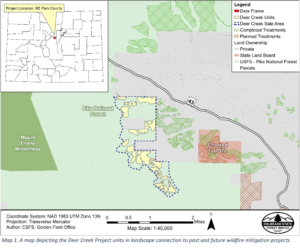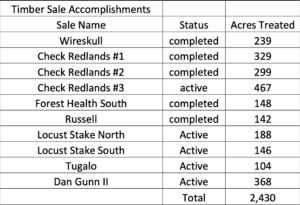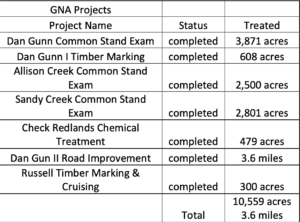When properly and actively managed, forests provide a wealth of benefits, including clean drinking water for over 68,000 American communities, millions of recreational and job opportunities, and critical wildlife habitat.
Good Neighbor Authority (GNA) allows the USDA Forest Service to enter into agreements of up to ten years with state forestry agencies to implement this critically important management work on national forests when the Forest Service is unable to do the work alone.
It is simply good government for forest management to be undertaken in the most timely and cost-efficient manner. Good Neighbor Authority helps us do that.
Since GNA was first authorized by Congress with the 2014 Farm Bill, at least 38 states have broken ground on more than 490 GNA projects. Through these GNA projects, states are contributing to the restoration of federal forests on a scale never before realized.
As a result of GNA’s success, Congress expanded Good Neighbor authorities to allow necessary road reconstruction and repairs (with the FY 2018 appropriations omnibus) and to empower tribes and counties to enter into GNA agreements (with the 2018 Farm Bill). Additionally, the Infrastructure Investment and Jobs Act (IIJA) allocates funding through FY 2026 for federal, state, and tribal authorities that enter GNA agreements for ecosystem restoration projects under the Tribal Forest Protection Act.
State Highlights
The Alabama Forestry Commission (AFC) currently has a GNA agreement with the USDA Forest Service in Alabama to handle timber sales in the Talladega National Forest, Oakmulgee District, and the Tuskegee National Forest. This agreement began in 2019 and will likely be renewed after its 2025 expiration. The AFC handles about one timber sale per year at Talladega (Oakmulgee) and to date has handled two timber sales at Tuskegee.
Good Neighbor Authority projects in Alaska take place in cooperation with the Tongass and Chugach National Forests and with the Bureau of Land Management. Projects include hazardous fuels reduction, spruce beetle mitigation and restoration, and watershed restoration.
One such agreement between the Alaska Division of Forestry and Tongass National Forest was designed to assist the timber industry in transitioning from old-growth harvesting to young-growth harvesting. The project, known as the Vallenar Young-Growth Good Neighbor Agreement, helps the timber industry develop new skills and strategies to adapt to young-growth harvest, reconditions a National Forest System Road, and restores hydrologic function to the Vallenar Creek watershed. Some of the first units affected by the agreement were harvested in the 1950s and have recently begun to reach maturity for young-growth forests.
The Arizona Department of Forestry and Fire Management (DFFM) engages private contractors and the Arizona Department of Corrections, Rehabilitation and Re-entry (ADCRR) forestry and fire crews to utilize a 2021 10-year Master Good Neighbor Agreement with all 6 National Forests. DFFM partners in single- and multi-project agreements to achieve its shared goals of hazardous fuels reduction, WUI protection, forest health and watershed improvements, wildlife habitat enhancement, invasive species abatement, and heritage inventory services. Under the 11 current agreements, 36,000 acres of timber removal and 23,000 acres of non-commercial treatments are planned or underway. Since 2020, more than 30,000 acres of timber have been marked/re-marked under a Pre-Sale agreement.
Greater Payson Project
The Greater Payson Restoration Project falls in the Payson Fireshed within the 4FRI Wildfire Crisis Strategy Landscape on the Tonto National Forest. The 14,265-acre project will improve 6 key watersheds that flow into the Verde and Salt watersheds while providing WUI protection to the Town of Payson by removing the encroached junipers, woodland, and brush species adjacent to high-valued private land and infrastructure.
Pumphouse Crossboundary Project
The Pumphouse Crossboundary Community Protection Project is located about 5 miles south of Flagstaff and covers a suite of activities to meet the goals and objectives of 4FRI in the Coconino National Forest. The purpose is to reduce fuels and lessen the risk and severity of damaging wildfire to the adjacent communities of Kachina Village, Forest Highlands, Pine Del, and Mountainaire, and to protect the Pumphouse Wash/Oak Creek/Upper Verde River watershed. Approximately 2,500 acres of federal land and 1,000 acres of adjacent state land are planned for commercial thinning. Initial work includes innovative pre-sale forest inventory and sale preparation activities involving remote sensing data collection, processing, and analysis.
Deer Creek Project

Since 2007, the Colorado State Forest Service in coordination with key local partners, such as the USFS South Platte Ranger District and the Platte Canyon Fire Protection District, have completed several wildfire mitigation projects in this area. The Deer Creek Project is strategically positioned to build on those past projects, completing forest management work and wildfire mitigation work on the adjacent lands in 2023. This collaborative project between the CSFS and the USFS is through the Good Neighbor Authority, and it’s the first of its kind in the Pike National Forest. The local community has demonstrated strong support for this project by identifying it for treatment in its Community Wildfire Protection Plan. An additional 340 acres are scheduled for forest management and wildfire mitigation work on state and private lands beginning in 2024.
White Cloud Project
The White Cloud Fuels Reduction Project funded under the White River National Forest Fuels Projects Good Neighbor Agreement created a Community Protection Zone on federal lands adjacent to communities in the wildland-urban interface (WUI) that have been identified as having an elevated risk of wildfire in Summit County, CO.
The goal of the White Cloud Fuels Reduction Project is to strategically connect, strengthen, and build upon the series of existing fuel breaks around the Breckenridge and Blue River area while regenerating an old forest. The project will reduce the volume and connectivity of fuels within the project area and reduce wildfire hazards to the adjacent neighborhood and greater Breckenridge, Blue River, and unincorporated southern Summit County communities. The cutting of live and dead trees mimics the ecologically beneficial effects of a fire, which the forest is adapted to, and will reduce fire intensity so firefighters will have a greater opportunity to engage safely in fire suppression activities in the event of a wildland fire.
Partners in this shared stewardship project include the Colorado State Forest Service, USDA Forest Service, Summit County, Town of Blue River, Town of Breckenridge, and the local wood products industry with critical access provided by private landowners.
By working closely with the local wood products industry, trees harvested from the project site will be used locally for dimensional lumber. Without this industry support, the project would have cost approximately $300,000. The capacity in the local wood products industry to utilize the trees helps to cover project costs and support local jobs and markets, while still protecting communities in the WUI and restoring a healthy forest. A thriving wood products industry is integral in completing fuels reduction treatments by reducing project costs and utilizing Colorado’s forest products instead of burning or chipping the wood.
Georgia Forestry Commission (GFC) has utilized the Good Neighbor Authority to complete seven GNA projects, treating over 10,000 acres cumulatively. The agency has also used GNA to do several timber sales, treating over 2,000 acres.


The Kentucky Division of Forestry (KDF) collaborates with the USDA Forest Service on Good Neighbor Authority agreements. They have used supplemental funding from GNA agreements to treat eastern hemlocks for protection against the invasive hemlock woolly adelgid within the Daniel Boone National Forest (DBNF). The Division was recently approved for an agreement to work on invasive plant, insect, and disease monitoring with the DBNF. GNA agreements have also enhanced other KDF programs like Wildland Fire.
Idaho Department of Lands (IDL) and the Forest Service are working together to plan and implement projects to address insect and disease outbreaks, reduce hazardous fuels, improve habitat, and repair Forest Service roads. To date, 20 timber sales have been awarded under GNA in Idaho that will treat over 6,500 acres and generate 71.6 million board feet of timber. Over 60 restoration service contracts at a total value of $3.5 have been awarded to the private sector to provide added capacity for restoration planning and implementation.
The Michigan Department of Natural Resources has partnered with the U.S. Forest Service since 2016 to implement the Good Neighbor Authority (GNA) program on the Huron-Manistee, Hiawatha and Ottawa National Forests in Michigan. This partnership has assisted these forests in treating over 25,000 acres and has produced more than 218 Million Board Feet (MMBF) of timber. These forest management activities have contributed to the expansion of economic opportunities in rural areas and have allowed the implementation of restoration activities to occur around the state, including:
- 2,090 acres of wildlife habitat improvement projects. Many of these projects restored the habitat for threatened and endangered species including Karner Blue Butterfly, Eastern Massasauga Rattlesnake, Kirtland’s Warbler and numerous turtle species.
- 354 acres of non-native invasive species surveys and control utilizing partnerships with local Cooperative Invasive Species Management Areas (CISMA’s)
- 53,021 acres of natural community and biotics surveys, necessary to meet National Environmental Policy (NEPA) requirements.
- 4,531 acres of regenerated young forests, helping to provide sustainable forests for the future.
Numerous partnerships with county road commissions, state universities, and other state agencies have made the restoration activities undertaken through this program possible. As this program continues to grow in Michigan the expertise these groups are able to provide will be essential in continuing the restoration efforts on Michigan’s National Forests.
The Mississippi Forestry Commission (MFC) has been working on several GNA projects with the USDA Forest Service since 2017.
- MFC has worked on seven projects using airplanes to detect, flag, map, and report the invasive Southern Pine Beetle in the Homochitto, Bienville, and Holly Springs National Forests.
- The Commission has worked with the USDA Forest Service on ten timber sale preparation projects that have covered around 4,000 acres.
- MFC has actively treated invasive plant species (specifically cogongrass) within the Desoto National Forest, treating over 400 acres in the four years since the partnership began.
The Montana Department of Natural Resources and Conservation (DNRC) has:
-
- Treated/contracted 24,770 total acres
- Completed/contracted 41 timber sales
- Completed/contracted 45 service restoration projects
- Harvested 6 million board feet
- Generated/contracted $13.6M revenue
Montana DNRC has engaged with the USDA Forest Service on a number of projects around the state, including:
- A service restoration to address best management practices along East Fork Elk Creek in the Kootenai National Forest.
- Stand treatment to promote large ponderosa pine, reduce wildfire risk, and improve winter range conditions on Threemile Game Range in the Bitterroot National Forest
- Pre-commercial thinning and hand piling to reduce wildfire risk and improve forest health and wildlife in Helena-Lewis & Clark National Forest.
In 2018, the Nebraska Forest Service (NFS) entered into a GNA agreement with Nebraska National Forests and Grasslands (NNF&G) to allow NFS to prepare, contract, and administer management on USDA Forest Service land in the state.
NFS has since completed or planned three projects under GNA:
- In November 2019, NFS carried out a 346.7-acre fuels reduction project at the site of a 2012 burn.
- NFS is currently executing a 210-acre project in the same 2012 burn footprint.
- NFS has funding in place to complete a third project, which will treat fuels in a green footprint.
The Box Canyon Fuels Reduction Good Neighbor Authority Project between the Claunch-Pinto Soil and Water Conservation District and the USDA Forest Service with state funding enhances the function of one of the last intact watersheds (Upper Arroyo de Manzano) in the Manzano Mountains of New Mexico.
The Box Canyon Project is a 300-acre USDA Forest Service land project in the Upper Arroyo de Manzano watershed. The project completed restoration treatments designed to reduce the threat of high-intensity wildfire by reducing the fuels on the remaining unburned forested watersheds in the central Manzanos.
This project was prioritized in the Torrance County and Claunch-Pinto Soil and Water Conservation District (district) 2016 Community Wildfire Protection Plans and the 2017 NM Communities at Risk. This project allowed the Mountainair Ranger District to improve watershed health, wildlife habitat, and recreational opportunities, as well as provide fuelwood and small-diameter raw wood material to the local community. This project benefited the Manzano Mutual Domestic Water Association and the Manzano Ditch Association, along with continued development of a landscape scale fuel break to help protect the villages of Manzano and Punta de Agua, NM.
The project was funded through New Mexico State Forestry. The district partnered with New Mexico Forest Industry Association, which was able to bid the thinning work out to several thinning contractors to help maintain a workforce, especially through these dire economic times.
In 2018, the North Dakota Forest Service (NDFS) and Dakota Prairie Grasslands (DPG) entered into a Good Neighbor Authority (GNA) agreement to maintain the health of ponderosa pine stands—the most northeasterly stands of native Ponderosa in North America—in the Medora Ranger District.
The project area has a history of continual fire suppression and is significantly overcrowded, leaving the stands vulnerable to fire and other risks. The GNA treatment includes reducing fuels and canopy coverage, as well as increasing tree canopy height and reducing ladder fuels to mitigate wildfire risk. By selectively removing individual trees and pruning, piling, and burning piles within dense ponderosa pine stands, the risk of catastrophic fire is reduced. The treatments also increase forage production and increase trees’ health and productivity.
Between 2018 and 2023, over 80 acres were treated in priority areas with assistance from USDA Forest Service Staff.
Since 2016, Oregon Department of Forestry (ODF) and Oregon Department of Fish and Wildlife (ODFW) have worked across all 11 National Forests in Oregon under 30 Supplemental Project Agreements. The results of this work include the:
- 52,000 acres of restoration project planning and project preparation
- 11,000 acres of non-commercial fuels reduction and thinning, prescribed fire preparation, noxious weed treatments, wildlife habitat improvement, and stream enhancement
- 14,000 acres of commercial restoration, producing 50 million board feet of timber volume
- 7 contracted National Environmental Policy Act (NEPA) Categorical Exclusions (CE) projects covering 30,000 acres
- 440 acres of post-implementation monitoring work
The Washington Department of Natural Resources (DNR) partnered with the Olympic National Forest (ONF) in 2020 under their existing Forest-wide Restoration GNA Agreement to begin the process of replacing a perched 72” culvert blocking approximately 1 mile of upstream critical salmon habitat. Leveraging state funding, this $300,000 aquatic organism passage project was considered a high priority for both agencies to meet multiple salmon recovery objectives.
This bridge is part of the 2D Restoration Thin timber sale project, focused on accelerating old-growth stand structure and habitat improvement, and was a collaboration of DNR’s Federal Lands and State Uplands engineers working with ONF and USDA Forest Service Region 6 engineers. DNR in-house engineers designed a permanent 70-foot steel bridge to be placed on driven piles for the location using DNR’s contracts and internal design processes. The 2D Restoration Thin timber sale generated approximately $800,000 in revenue to be used as part of the project and future terrestrial and aquatic habitat restoration projects.
The Buffalo Municipal Watershed Good Neighbor Agreement is the second agreement in Wyoming designed to protect and restore a municipal watershed.
Covering over 38,000 acres, this agreement between Bighorn National Forest and Wyoming State Forestry Division, Wyoming Game & Fish, and multiple other partners is currently in phase two of a multi-phase, cross-boundary Good Neighbor project which includes, fuels reduction by mechanical and hand methods, prescribed burning, aspen restoration, beaver dam analog construction, road management and maintenance, and commercial timber harvest.
Interested in learning more about GNA projects?
Head to the USDA Forest Service’s website and explore our Project Map Viewer.
We thank the Council of Western State Foresters for their invaluable contributions to the NASF website.
A number of additional resources are available on the Western Forestry Leadership Coalition’s GNA Information and Resources webpage at the following link: https://www.thewflc.org/partnerships/gna-information-and-resources

